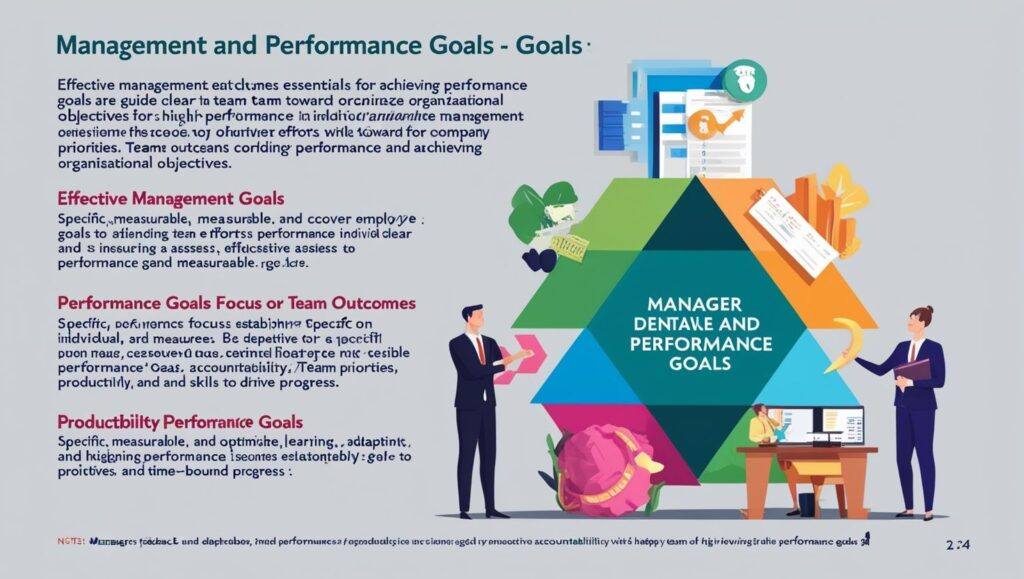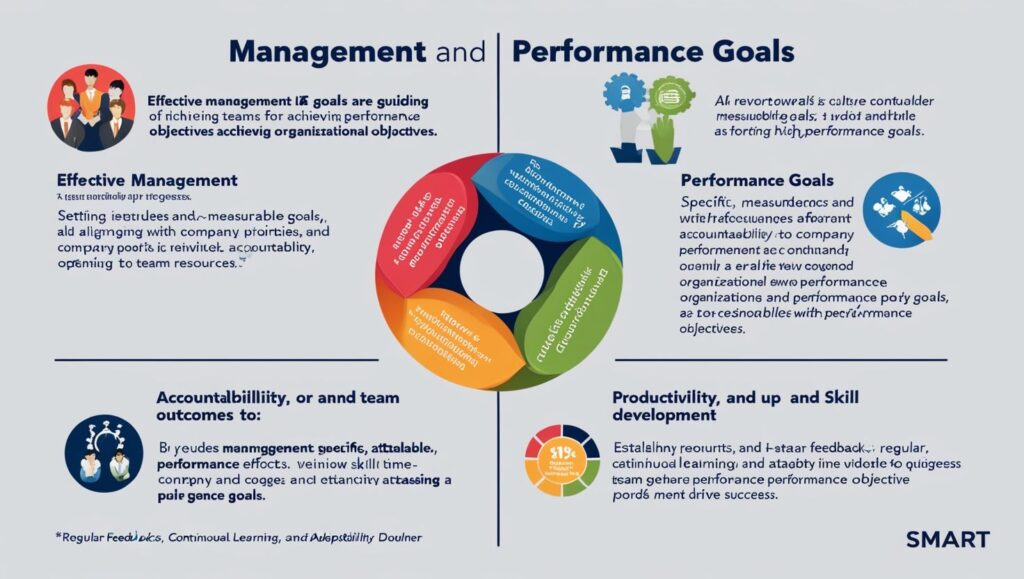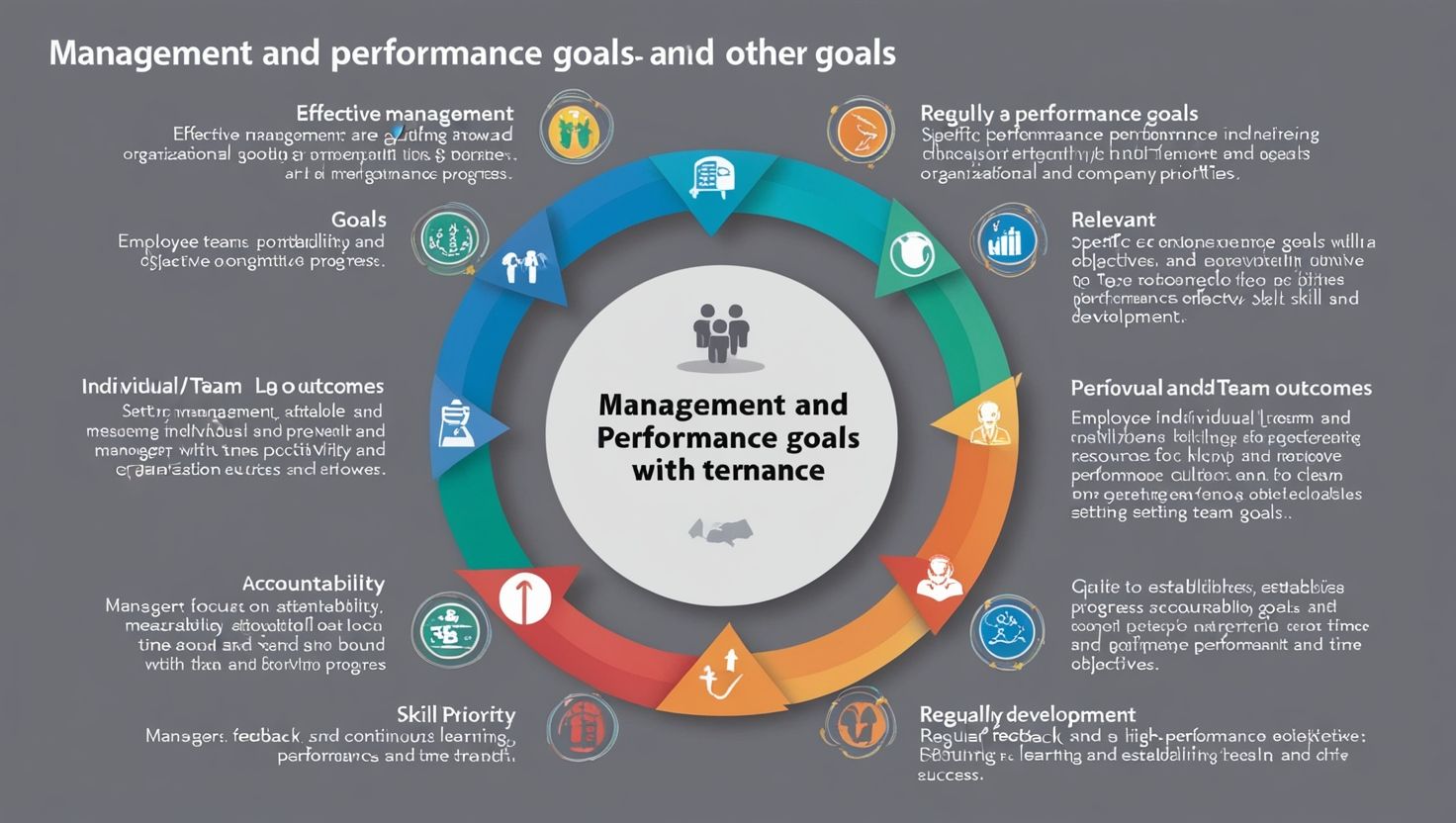Management and Performance Goals, Management is a cornerstone of any organization, playing a crucial role in achieving objectives, optimizing resources, and fostering growth. In modern times, management practices have evolved, emphasizing measurable results and structured goal-setting. This article explores management as a discipline, its focus on results, and the importance of setting performance goals and targets.
The Essence of Management
Management involves planning, organizing, leading, and controlling resources, including human capital, finances, and materials, to achieve organizational goals efficiently and effectively. It acts as the glue that holds various organizational processes together.
Key functions of management include:
- Planning: Establishing objectives and determining the best course of action to achieve them.
- Organizing: Allocating resources and assigning tasks to ensure efficient operation.
- Leading: Motivating and guiding employees toward achieving organizational goals.
- Controlling: Monitoring progress and making adjustments to stay aligned with objectives.
Management is not static; it evolves with organizational needs, market conditions, and technological advancements, making adaptability a vital attribute.
Management for Results
Management for Results (MfR) emphasizes outcomes rather than processes. It shifts focus from routine activities to tangible achievements that align with an organization’s mission and vision. This approach ensures accountability, promotes transparency, and drives efficiency.
Key Characteristics of MfR
- Outcome-Oriented Approach: Results are clearly defined, measurable, and aligned with organizational priorities.
- Evidence-Based Decision-Making: Data and analytics guide decision-making processes.
- Accountability and Ownership: Teams and individuals are responsible for achieving specific results.
- Continuous Improvement: Regular reviews and evaluations help refine strategies and improve performance.

Benefits of MfR
- Enhanced focus on strategic goals.
- Improved resource allocation.
- Greater employee engagement through clarity of purpose.
- Stronger accountability mechanisms.
Organizations that adopt MfR often implement tools such as performance dashboards and Balanced Scorecards to track and measure progress.
Performance Goals and Targets
Understanding Performance Goals
Performance goals are broad, long-term objectives that define what an organization or individual aims to achieve. They provide direction, set expectations, and serve as benchmarks for success.
Understanding Performance Targets
Performance targets are specific, measurable milestones that support the achievement of performance goals. They are actionable, time-bound, and often quantitative, offering a clear path to success.
The Process of Setting Goals and Targets
- Identify Objectives: Begin with a clear understanding of what the organization aims to accomplish.
- Engage Stakeholders: Involve team members to ensure alignment and buy-in.
- Set SMART Goals: Goals should be Specific, Measurable, Achievable, Relevant, and Time-bound.
- Define Performance Indicators: Establish metrics to measure progress and success.
- Break Down Goals into Targets: Translate broader objectives into actionable steps.
- Monitor and Adjust: Regularly review progress and make necessary adjustments.
Strategic Frameworks for Goal-Setting
OKRs (Objectives and Key Results):
- Objectives: Qualitative, aspirational goals.
- Key Results: Quantifiable outcomes that indicate progress toward objectives.
- Balanced Scorecard:
- Aligns goals across financial, customer, internal processes, and learning and growth perspectives.
- KPIs (Key Performance Indicators):
- Specific metrics used to track performance against targets.
Challenges in Goal-Setting and Achieving Results
- Ambiguity in Objectives: Poorly defined goals can lead to confusion and misalignment.
- Lack of Resources: Insufficient resources can hinder progress.
- Resistance to Change: Employees may resist new methodologies or expectations.
- Ineffective Communication: Failure to communicate goals clearly can derail efforts.
- Overemphasis on Quantitative Metrics: Focusing solely on numbers may overlook qualitative achievements.

Best Practices for Management and Goal Achievement
- Incorporate Flexibility: Adapt goals as circumstances change.
- Leverage Technology: Use tools for tracking progress and automating routine tasks.
- Foster a Collaborative Environment: Encourage teamwork and open communication.
- Celebrate Milestones: Acknowledge and reward achievements to maintain motivation.
- Invest in Training: Equip employees with the skills needed to meet targets.
Case Studies: Management and Goal-Setting in Action
Case Study 1: Google’s OKR System
Google popularized the use of OKRs, which helped the company maintain a focus on ambitious yet achievable goals. By setting clear objectives and measurable key results, Google achieved rapid growth while fostering innovation.
Case Study 2: Toyota’s Lean Management
Toyota employs lean management principles, focusing on efficiency and continuous improvement. By setting performance targets tied to productivity and quality, Toyota revolutionized the automotive industry.
Conclusion
Management, when aligned with results and supported by structured goal-setting, becomes a powerful tool for organizational success. The focus on results ensures accountability, while SMART goals and performance targets provide a clear roadmap. Embracing modern frameworks and overcoming challenges through best practices enable organizations to thrive in competitive environments. By investing in MfR, organizations can unlock their potential and achieve sustainable growth.

Scrapbooking for Less Promo Code Unlock savings with our Scrapbooking for Less secret coupon code!
k3845k
It’s actually a great and useful piece of info. I am happy that you simply shared this helpful info with us. Please keep us up to date like this. Thank you for sharing.
LwZXaUX PAAHWgv zDcUuU yxnMSJ
Wake up your way with this premium CD player alarm clock radio. Whether you prefer to rise with the AM/FM radio, your favorite CD, or a standard buzzer, this versatile alarm clock with CD player has you covered. Its intuitive design includes dual alarms, a large digital display, snooze/sleep timers, and USB charging for your phone. Enjoy high-quality stereo sound from a compact unit that fits easily on any bedside table or shelf. The best clock radios with CD player combine retro functionality with modern convenience—and this one leads the pack.
Unquestionably believe that which you said. Your favourite justification seemed to be on the internet the simplest thing to take note of. I say to you, I certainly get annoyed even as folks consider issues that they plainly do not recognize about. You controlled to hit the nail upon the top as well as outlined out the whole thing without having side-effects , other people can take a signal. Will probably be again to get more. Thank you
Utterly written written content, Really enjoyed looking at.
Hi there, simply was alert to your blog through Google, and found that it’s truly informative. I’m going to be careful for brussels. I will be grateful if you happen to continue this in future. Numerous other folks will probably be benefited from your writing. Cheers!
It’s hard to find knowledgeable people on this topic, but you sound like you know what you’re talking about! Thanks
Some truly interesting details you have written.Aided me a lot, just what I was searching for : D.
An attention-grabbing dialogue is value comment. I believe that you must write extra on this matter, it won’t be a taboo subject but generally individuals are not sufficient to talk on such topics. To the next. Cheers
You are a very intelligent individual!
Excellent read, I just passed this onto a friend who was doing some research on that. And he just bought me lunch because I found it for him smile Thus let me rephrase that: Thanks for lunch! “Dreams are real while they last. Can we say more of life” by Henry Havelock Ellis.
You have brought up a very excellent details, thankyou for the post.
This web site is really a walk-through for all of the info you wanted about this and didn’t know who to ask. Glimpse here, and you’ll definitely discover it.
Whats Taking place i’m new to this, I stumbled upon this I’ve found It absolutely helpful and it has helped me out loads. I am hoping to contribute & aid different customers like its helped me. Good job.
I beloved as much as you’ll receive performed right here. The cartoon is attractive, your authored material stylish. nevertheless, you command get bought an shakiness over that you want be delivering the following. sick indisputably come more previously again since precisely the same nearly very ceaselessly inside case you protect this hike.
excellent post, very informative. I wonder why the other specialists of this sector don’t notice this. You must continue your writing. I’m confident, you’ve a huge readers’ base already!
Good info. Lucky me I reach on your website by accident, I bookmarked it.
I loved as much as you’ll receive carried out right here. The sketch is attractive, your authored material stylish. nonetheless, you command get got an edginess over that you wish be delivering the following. unwell unquestionably come further formerly again as exactly the same nearly a lot often inside case you shield this hike.
I really like what you guys are usually up too. Such clever work and exposure! Keep up the awesome works guys I’ve you guys to blogroll.
Hi there! Someone in my Facebook group shared this site with us so I came to check it out. I’m definitely enjoying the information. I’m bookmarking and will be tweeting this to my followers! Terrific blog and wonderful style and design.
I consider something genuinely special in this web site.
I?¦ve learn several excellent stuff here. Certainly value bookmarking for revisiting. I surprise how so much effort you put to make this sort of magnificent informative web site.
An interesting discussion is worth comment. I think that you should write more on this topic, it might not be a taboo subject but generally people are not enough to speak on such topics. To the next. Cheers
You actually make it seem so easy together with your presentation but I in finding this matter to be actually one thing which I believe I might never understand. It seems too complicated and extremely broad for me. I am having a look ahead in your subsequent publish, I will try to get the cling of it!
Hello this is kinda of off topic but I was wanting to know if blogs use WYSIWYG editors or if you have to manually code with HTML. I’m starting a blog soon but have no coding know-how so I wanted to get guidance from someone with experience. Any help would be enormously appreciated!
Hi! I could have sworn I’ve been to this blog before but after checking through some of the post I realized it’s new to me. Nonetheless, I’m definitely glad I found it and I’ll be bookmarking and checking back frequently!